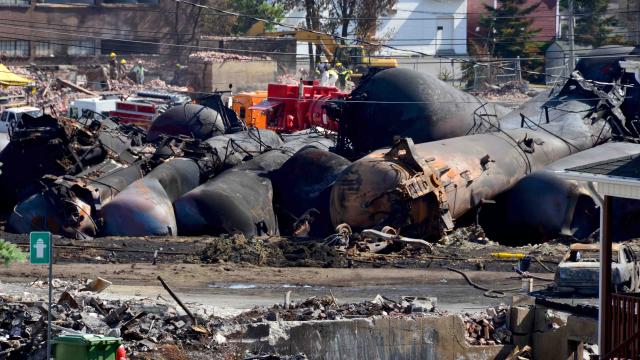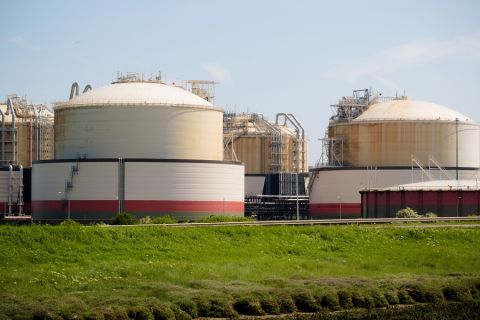
The July 2013 rail disaster at Lac-Mégantic, Safety Data Sheets Quebec, called attention to the differing volatility— and handling requirements—of crude oils. (Source: Shutterstock)
Some safety and environmental advocates have argued the July 2013 Lac-Mégantic rail disaster in Québec highlighted that not all crude oil is created equal. Specifically, these critics have argued that crude from the Williston Basin’s Bakken formation possesses chemical properties that vary from much of the other crude produced in the U.S.
While industry representatives have taken issue with many of the concerns about Bakken crude, the fact remains that crude from distinct sources can differ in significant respects.
Importantly, the guidance of the U.S. Occupational Safety and Health Administration (OSHA) continues to indicate that producers and distributors of petroleum have an obligation under the agency’s Hazard Communication Standard (HCS) to provide downstream recipients with a Safety Data Sheet (SDS) for crude. The SDS must properly reflect the petroleum stream at issue—rather than all crude oils, generically.
Like upstream producers, midstream businesses need to understand their SDS obligations and the cost of compliance and non-compliance.
SDS Background
OSHA’s HCS was adopted in 1983 for manufacturers. In 1987, the agency expanded the scope to all industries in which employees are potentially exposed to hazardous chemicals.
Under the HCS, chemical manufacturers and importers are required to evaluate the chemicals and engage in a classification process to determine if and how each is hazardous. Information about hazards and protective measures must be conveyed to downstream employers through labels on containers and through SDS’s, formerly referred to as a Material Safety Data Sheet (MSDS). Each SDS must be up to date.
In 2012, OSHA substantially revised the HCS to conform it to the United Nations’ Globally Harmonized System of Classification and Labelling of Chemicals (GHS).
In the 2012 HCS, the information contained in the SDS is largely the same as what was required of the MSDS. However, the SDS must be presented in a consistent, user-friendly, 16-section format.
Under the HCS, “chemical” is defined as “any substance, or mixture of substances.” A “chemical manufacturer” includes any “employer with a workplace where chemical(s) are produced for use or distribution.” And to “produce” means “to manufacture, process, formulate, blend, extract, generate, emit, or repackage.”
No Generic Crude
In a 1996 interpretation letter, OSHA concluded that “[o]il and gas producers are covered by the HCS and are considered chemical manufacturers.” It withdrew a statement that was made in a 1989 letter, citing the prior statement as “erroneous.” Further, however, OSHA stated in the 1996 letter that, as was stated in 1989, oil and gas producers can use a “generic MSDS.”
With the 2012 amendments to the HCS, it was apparent that OSHA would no longer consider a truly generic SDS for all crude oil as acceptable. This conclusion is confirmed by a March 4, 2014, OSHA interpretation letter in which it explained that “[w]hen dealing with petroleum streams, it may be more important for the user to know the concentrations of particular groups of constituents that are toxicologically similar.”
The letter ultimately recognizes and accepts that a producer of petroleum cannot provide an SDS with absolutely precise information about the constituents of the crude oil, including the levels of those constituents, due to the variable nature of a petroleum stream. But it is also apparent from the letter that a truly generic SDS for crude oil generally would not be adequate.
Within certain limits of reasonableness, the letter evidences that OSHA expects a crude oil producer to develop an SDS that is correct for the petroleum stream at issue.
SDS Obligations
Again, under the terms of the HCS, producers of oil and gas and other chemical manufacturers must “obtain or develop [an SDS] for each hazardous chemical they produce or import.”
The SDS must be in English and must include 16 different designated sections, addressing a variety of different concerns, such as hazard identification, accidental-release measures, and “composition information on ingredients,” “physical and chemical properties” and “stability and reactivity.” (See graphic.)
If no applicable information exists for a particular section, the manufacturer must indicate in the SDS, that no applicable information was found.
The chemical manufacturer must ensure that the information provided accurately reflects the scientific evidence used in making the hazard classification. If the manufacturer preparing the SDS becomes newly aware of any significant information regarding the hazards of a chemical—or ways to protect against the hazards—this new information shall be added to the SDS within three months.
The chemical manufacturer must ensure that distributors and employers are provided with an appropriate SDS with the initial shipment and with the first shipment after an SDS is updated.
The manufacturer must either provide SDS’s with the shipped containers or send them to the distributor or employer prior to or at the time of the shipment. The manufacturer also must provide downstream distributors or employers with an SDS upon request.
Oil Distributors
Under the HCS, a “distributor” is “a business, other than a chemical manufacturer or importer, which supplies hazardous chemicals to other distributors or to employers.” If the company is a “distributor” of the crude oil, then, it must ensure that SDS’s and updated information are provided to other distributors and employers downstream with their initial shipment and with the first shipment after an SDS is updated.
A distributor must either provide SDS’s with the shipped containers or send them to the other distributor or employer prior to or at the time of the shipment.
As for whether a midstream crude-transportation or -storage business is a “chemical manufacturer” or “distributor,” it appears that there is a strong argument that a company that mixes crude streams from different producers is a “chemical manufacturer” that must create its own SDS.
Additionally, the concept of the midstream business simply passing along to all downstream recipients of its commingled product the disparate SDS’s received from the original producers seems untenable.
Of course, for a midstream business to comply with OSHA’s HCS requirements, the company should require the businesses from which it receives crude oil to provide it with SDS’s. Those SDS’s would be key to the midstream company’s development of an appropriate SDS.
Again, a producer is supposed to provide an SDS before or at the time of the first shipment. Also, if a recipient downstream requests a SDS, the producer must provide the SDS “upon request.”
Cost of Compliance
A midstream business producing a mixture of petroleum streams is well advised to provide an appropriate SDS to downstream recipients. But creating an SDS will not always be a simple undertaking.
As indicated by OSHA guidance, including the 2014 interpretation letter and a 2015 instruction, establishing the contents of an appropriate SDS will require some individualized analysis of the petroleum stream at issue. The letter and instruction include essentially the same important information about how that analysis should be conducted in the case of a petroleum-stream SDS.
The American Petroleum Institute has indicated that larger energy companies typically have sizeable teams of individuals that work on SDS development and updating—including specialists in chemistry, toxicology, industrial hygiene, occupational and environmental health, and other disciplines.
Smaller businesses may conclude that they cannot afford to devote those kinds of resources to SDS development. However, the OSHA guidance would indicate that a large team is not always necessary. A good-faith effort at compiling an appropriate SDS based upon the characteristics of the particular stream is better than making no effort at all or simply using a truly generic crude oil SDS from some source.
Additionally, covered companies should recognize highly skilled, third-party consulting firms are available to assist in development of an SDS.
As for the cost of SDS non-compliance, an OSHA “other than serious” citation currently carries a monetary penalty of up to $13,268 per violation. It might find the failure to provide an appropriate SDS for multiple products or streams to be separate violations, thus separate fines.
Further, if OSHA were to conclude that the failure to comply with SDS requirements was “willful,” then the potential penalty becomes as much as $132,598 per violation.
Downstream Demand
Perhaps the greatest practical difficulty associated with non-compliance is downstream recipients’ demand, as they should, that the upstream provider supply an appropriate SDS. The midstream business will have little choice but to comply.
If the business fails to supply an appropriate SDS, it could face a host of concerns, including potential breach-of-contract claims by downstream recipients, OSHA citations and increased exposure—in the case of a fire or explosion downstream—based on the theory that the failure to provide an accurate SDS constitutes evidence of negligence.
In sum, a producer of crude oil, including the midstream producer of a mixture of crude oils from different sources, is best served by making a good-faith effort to develop, deliver and, when appropriate, update SDS’s for the streams it provides to downstream recipients.
Bob Nichols is a partner with Bracewell LLP. He specializes in energy-employment issues.
Recommended Reading
Russia Orders Companies to Cut Oil Output to Meet OPEC+ Target
2024-03-25 - Russia plans to gradually ease the export cuts and focus on only reducing output.
BP Starts Oil Production at New Offshore Platform in Azerbaijan
2024-04-16 - Azeri Central East offshore platform is the seventh oil platform installed in the Azeri-Chirag-Gunashli field in the Caspian Sea.
Exxon’s Payara Hits 220,000 bbl/d Ceiling in Just Three Months
2024-02-05 - ExxonMobil Corp.’s third development offshore Guyana in the Stabroek Block — the Payara project— reached its nameplate production capacity of 220,000 bbl/d in January 2024, less than three months after commencing production and ahead of schedule.
Venture Global, Grain LNG Ink Deal to Provide LNG to UK
2024-02-05 - Under the agreement, Venture Global will have the ability to access 3 million tonnes per annum of LNG storage and regasification capacity at the Isle of Grain LNG terminal.
What's Affecting Oil Prices This Week? (Feb. 5, 2024)
2024-02-05 - Stratas Advisors says the U.S.’ response (so far) to the recent attack on U.S. troops has been measured without direct confrontation of Iran, which reduces the possibility of oil flows being disrupted.



